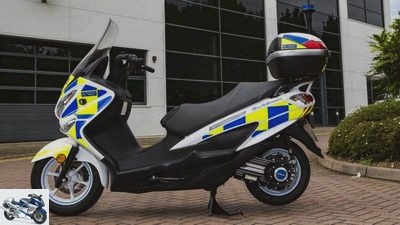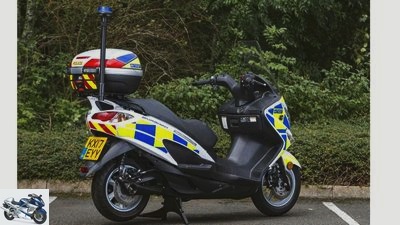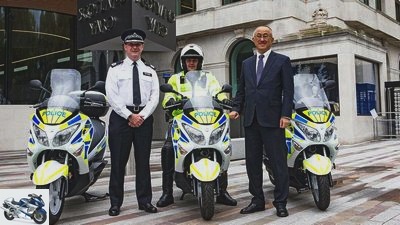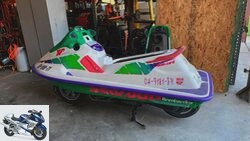Table of contents
- Patent fuel cell scooter Suzuki continues to research the hydrogen scooter
- Drive always different
- Patent 2021
- opinion poll
- Conclusion

Suzuki




9 pictures

Suzuki
1/9
This is what the Burgmann with fuel cell could look like. As usual, the only missing helmet compartments are to be expected.

Suzuki
2/9
The great technology of the fuel cell drive is hidden under the body. The tank # 35 is in the footwell, above the battery # 16, the control units # 17, 18 and the fuel cell # 2. The motor # 3 sits in the swing arm # 9

Suzuki
3/9
Interesting: at the very front the # 19 is named in the patent as the control unit for the hydrogen. It regulates the inflow and outflow of hydrogen and is therefore perhaps so close to crash zones: for a quick shutdown.

Suzuki
4/9
This is how it all started in 2009: fuel cells and motor are still water-cooled, which explains the generous dimensions. In 2021 everything will be air-cooled.

Suzuki
5/9
In 2010 the first changes to the drive were made. Narrower and apparently air-cooled.

Suzuki
6/9
In 2011 the Burgman got street legal, but was never sold. Again, the drive is smaller.

Suzuki
7/9
In 2017, the London police received a number of E-Burgmanns with fuel cells for an 18-month test.

Suzuki
8/9
Like all of its predecessors, it has a two-armed swing arm …

Suzuki
9/9
… even if the drive is smaller again, resembling a drive train swing arm.
counselor
technology & future
Elektro-Burgman patented with hydrogen: fuel cell at Suzuki
Patent fuel cell scooter
Suzuki continues to research the hydrogen scooter
For 12 years the Suzuki Burgman with fuel cell haunted the media again and again. A new patent application in Germany fires the electric scooter again.
Jens Kratschmar
03/26/2021
It all starts in 2009 at the Tokyo Motor Show. Suzuki shows a scooter study with fuel cells. The technical basis is the large roller Suzuki Burgman. In 2010 it will be tested on British roads, in 2011 it will be approved for road use and in 2014 it will be on the Eicma in a very practical way. The project will remain quiet until 2017, when the London police put some hydrogen scooters in a test over 18 months. Since then: calm. Until now: In Germany, a patent from Suzuki appears that a vehicle can be protected with a hydrogen tank and fuel cell. Visually clearly a Burgman. Technically: Again a little different from the previous studies.
Drive always different
What all fuel cell Burgman have in common so far was the basic frame construction with the hydrogen tank under the driver’s footwell, as well as the corresponding body of the respective model year. In 2009, the water-cooled drive was built extremely broadly on the rear wheel, and boldly laid cooling lines outside the body emphasized the concept of study. The version from 2001 also uses a wheel hub motor, which apparently works without cooling and is correspondingly narrow. The next appearance in 2014 in Milan will then show another drive variant, not unlike a drive unit swing arm in shape and position. Furthermore, the tank is clearly oriented towards the rear, the lithium-ion battery sits above it and the air-cooled fuel cell is located in the broad rear of the Burgmann, with an unfavorable focus. In the version of the London police from 2017, the drive is again slimmer, the other components appear to be in the positions from 2014. What all expansion stages have in common is that the rear wheel always sits in a two-arm swing arm.

Scooter
Amphibian self-made Toledo Seascoot
What Corona does to a Suzuki Burgman
read more
Patent 2021
In Germany, a patent was protected in March 2021 that relocated the drive and the position of the large components. The pressure tank for the hydrogen sits a little closer to the front wheel, the energy storage above is designated as a secondary battery, which represents a small energy buffer for the significantly smaller fuel cell. And here comes the big difference: In this patent, the motor and swing arm are one unit, i.e. they form a single-sided swing arm with an integrated, air-cooled wheel hub motor. Whether it has recuperation is unclear, but it would be logical because it is not centered on the bike and apparently has an intermediate gear with freewheel or a charging function.
The filler neck, the location and control of which is a large part of the new patent, is located in the footwell paneling. Most of the control devices for hydrogen technology are located between the battery and the significantly smaller fuel cell. A safety device with a tilt sensor, which is important for hydrogen operation, is located exactly behind the front wheel, which indicates that all cut-off devices are mechanically triggered in the event of a crash.
opinion poll
How do you feel about the electric motorcycle??
Voted 7 times in 2018
Out of the question for me.
The future of the two-wheeler for urban traffic.
There is no getting around the electric motorcycle.
Conclusion
Of all people, Suzuki. The men and women are consistently sticking to technology, some of which is over 20 years old, doing research on the fuel cell in silence, and whenever you think the project is dead, the Burgman reappears with the hydrogen tank. The drive configuration changes again and again and shows the innovative strength and real will to bring the fuel cell.
Related articles
-
Mobi-Ion AM1 e-scooter with fuel cell
Mobi-Ion 7th pictures Mobi-Ion 1/7 The French company Mobi-Ion has presented an electric scooter with fuel cell drive. Mobi-Ion 2/7 The AM1 in this form…
-
Honda has filed patents on a fuel cell motorcycle.
Honda 8th pictures Honda 1/8 Honda has patented a motorcycle with a fuel cell drive. Honda 2/8 The concept is based on an air-cooled fuel cell and a…
-
Suzuki electric scooter patent: electric and air-cooled
Suzuki Motorcycles 4th pictures Suzuki Motorcycles 1/4 This is what the Suzuki electric scooter could look like. Drive probably via chain or belt,…
-
Comparison test BMW K 1300 R, Buell 1125 CR, Suzuki B-King, Yamaha Vmax
K 37 pictures Yamaha 1/37 First look at the device from all sides… Yamaha 2/37 Yamaha 3/37 Yamaha 4/37 Yamaha 5/37 Yamaha 6/37 Yamaha 7/37 What is…
-
Team Suzuki Classic Katana: Extremely sharp long sword
Team Suzuki Classic 24 pictures Team Suzuki Classic 1/24 The Suzuki Classic team is behind the racing activities of Suzuki in historic motorsport. Team…
-
Suzuki Burgman 400: From late summer with Euro 5
News 2022 New motorcycle items for 2022 Suzuki 14th pictures Suzuki 1/14 Suzuki is sending the Burgman 400 facelifted into model year 2021. Suzuki 2/14…
-
Gargolov 12th pictures Jorg Rettenmayr 1/12 The suitcase holds a wild strap orgy… Michael Pfeiffer 2/12 …The first refueling stop after 111…
-
Katalis Spacebar Study: Essence of E-Mobility
Katalis design 4th pictures Katalis design 1/4 The electric motor with 1.2 kilowatts or 1.6 PS sits in the wheel hub. Katalis design 2/4 The strut of the…
-
Aral counselor traffic & business Basics: alternative drives Basics: alternative drives What could drive us in the future Refueling was yesterday. And…
-
Suzuki Hayabusa: 190 PS, 299 km-h top speed
News 2022 New motorcycle items for 2022 Suzuki 40 pictures Suzuki 1/40 Suzuki brings the third generation of the Hayabusa in 2021. It all started in…